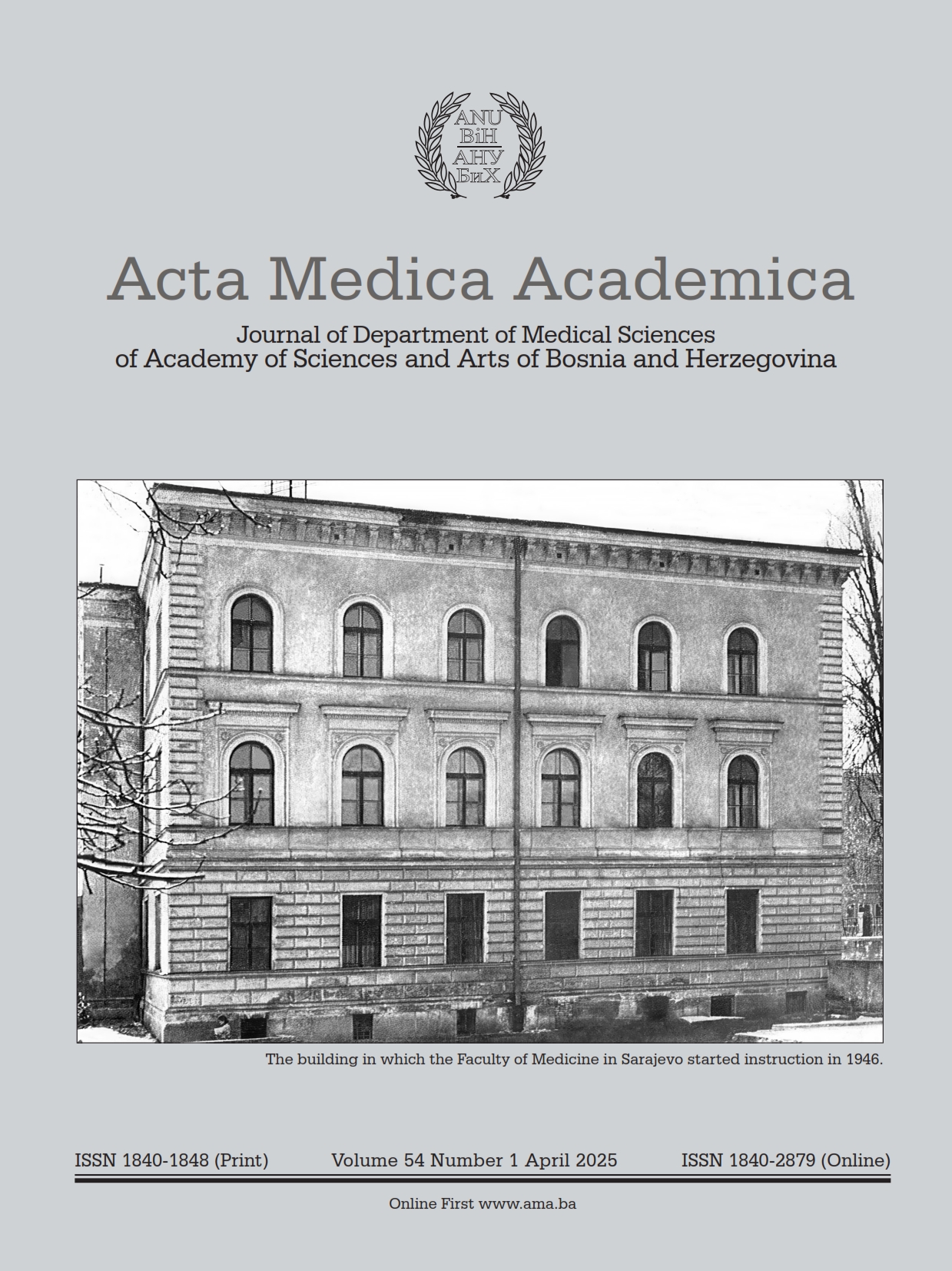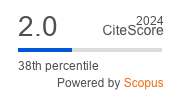Evaluation of BI-RADS 3 Ultrasound Findings: the Frequency and Incidence of Malignant Lesions, and Tumor Size
DOI:
https://doi.org/10.5644/ama2006-124.467Keywords:
BI-RADS Category 3, Ultrasound, Tumor Size, Breast Cancer, Follow-upAbstract
Objective. The aim of the research was to determine the frequency of BI-RADS category 3 findings in ultrasound examinations in relation to the total number of patients, the frequency of malignant lesions, and their average size at the time of detection in BI-RADS 3 ultrasound findings.
Patients and Methods. A cross-sectional study was performed on 335 patients (aged 40-75 years) classified in BI-RADS category 3, at the Tuzla Breast Center, University Clinical Center, in the period from March 2017 to November 2020. A total of 13,760 ultrasound examinations were performed, using a Toshiba Xario 100 ultrasound machine with a 12 MHz linear probe. Patients were divided into premenopausal and postmenopausal groups, excluding patients with symptoms and those with previous breast cancer surgery. The images were stored using the Institution’s Pictures Activation and Communication System.
Results. BI-RADS category 3 findings accounted for 27% of all ultrasound examinations (N=3.715). Of these, 9.02% (N=335) underwent recommended short-term follow-up. Malignancy was identified in 1.49% of these cases (N=5), with an average tumor size of 13.6 mm at detection. The malignancy rate did not differ significantly between premeno- pausal and postmenopausal patients (P=0.412). The overall diagnostic yield for malignancy in BI-RADS 3 findings was low, but clinically significant.
Conclusion. While the malignancy rate for BI-RADS category 3 findings is low (1.49%), careful monitoring and adherence to follow-up guideline are essential to balance early detection with avoidance of unnecessary biopsies and associated costs.
References
Costantini M, Belli P, Lombardi R, Franceschini G, Mulè A, Bonomo L. Characterization of solid breast masses: use of the sonographic breast imaging reporting and data system lexicon. J Ultrasound Med. 2006;25(5):649-59; quiz 661. doi: 10.7863/jum.2006.25.5.649.
Kim EK, Ko KH, Oh KK, Kwak JY, You JK, Kim MJ, et al. Clinical application of the BI-RADS final assessment to breast sonography in conjunction with mammography. AJR Am J Roentgenol. 2008;190(5):1209-15. doi: 10.2214/AJR.07.3259.
Rahbar G, Sie AC, Hansen GC, Prince JS, Melany ML, Reynolds HE, et al. Benign versus malignant solid breast masses: US differentiation. Radiology. 1999;213(3):889-94. doi: 10.1148/radiology.213.3.r99dc20889.
Shin HJ, Ko ES, Yi A. Breast cancer screening in Korean woman with dense breast tissue. J Korean Soc Radiol. 2015;73(5):279-86. doi: https://doi.org/10.3348/jksr.2015.73.5.279.
Zhao CH, Xiao M, Liu H, Wang M, Wang H, Zhang J, et al. Reducing the number of unneccesary biopsies of US-BI RADS 4a lesions trough a deep learning method for residents-in-training: a cross-sectional study. BMJ. 2020;10:e035757. doi:10.1136/ bmjopen-2019-035757.
Bowles EJ, Sickles EA, Miglioretti DL, Carney PA, Elmore JG. Recommendation for short-interval follow-up examinations after a probably benign assessment: is clinical practice consistent with BI-RADS guidance AJR Am J Roentgenol. 2010;194(4):1152-9. doi: 10.2214/AJR.09.3064.
Messinger J, Crawford S, Roland L, Mizuguchi S. Inappropriate use of BI-RADS Category 3: Learning from mistakes. Appl Radiat Oncol. 2019;(1):28-33.
Buchberger W, Geiger-Gritsch S, Knapp R, Gautsch K, Oberaigner W. Combined screening with mammography and ultrasound in a population-based screening program. Eur J Radiol. 2018;101:24-9. doi: 10.1016/j.ejrad.2018.01.022. Epub 2018 Jan 31.
Nam SY, Ko EY, Han BK, Shin JH, Ko ES, Hahn SY. Breast Imaging Reporting and Data System Category 3 Lesions Detected on Whole-Breast Screening Ultrasound. J Breast Cancer. 2016;19(3):301-7. doi: 10.4048/jbc.2016.19.3.301. Epub 2016 Sep 23.
Kim SJ, Chang JM, Cho N, Chung SY, Han W, Moon WK. Outcome of breast lesions detected at screening ultrasonography. Eur J Radiol. 2012;81(11):3229-33. doi: 10.1016/j.ejrad.2012.04.019. Epub 2012 May 14.
Hooley RJ, Greenberg KL, Stackhouse RM, Geisel JL, Butler RS, Philpotts LE. Screening US in patients with mammographically dense breasts: initial experience with Connecticut Public Act 09-41. Radiology. 2012;265(1):59-69. doi: 10.1148/radiol.12120621. Epub 2012 Jun 21.
Barr RG, Zhang Z, Cormack JB, Mendelson EB, Berg WA. Probably benign lesions at screening breast US in a population with elevated risk: prevalence and rate of malignancy in the ACRIN 6666 trial. Radiology. 2013;269(3):701-12. doi: 10.1148/radiol.13122829. Epub 2013 Oct 28.
Chae EY, Cha JH, Shin HJ, Choi WJ, Kim HH. Reassessment and Follow-Up Results of BI-RADS Category 3 Lesions Detected on Screening Breast Ultrasound. AJR Am J Roentgenol. 2016;206(3):666-72. doi: 10.2214/AJR.15.14785.
Lee KA, Talati N, Oudsema R, Steinberger S, Margolies LR. BI-RADS 3: Current and Future Use of Probably Benign. Curr Radiol Rep. 2018;6(2):5. doi: 10.1007/s40134-018-0266-8. Epub 2018 Jan 27.
Muthuvel D, Mohakud S, Deep N, Muduly D, Kumar P, Mishra P, et al. Usefulness of Combined Advanced Dynamic Contrast-Enhanced and Diffusion-Weighted MRI Over Ultrasonography in Differentiating Cancer From Benign Lesions in Dense Breasts. Cureus. 2024;16(9):e69634. doi: 10.7759/cureus.69634.
Downloads
Published
License
Copyright (c) 2025 Hanifa Fejzić, Svjetlana Mujagić, Belkisa Izić

This work is licensed under a Creative Commons Attribution-NonCommercial 4.0 International License.





